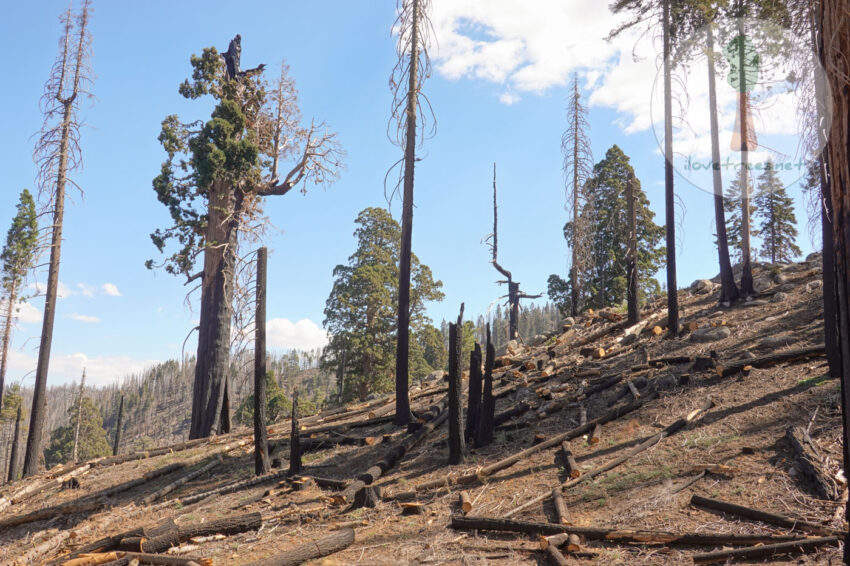by Sue Cag
Packsaddle Grove and the surrounding forest have been decimated by the Forest Service / Save the Redwoods League. Bulldozers have ripped apart the earth, up and down every steep slope, across every ridge and drainage, turning the forest into dust. Tree trunks lie like pick up sticks across the ground in every direction. Many more logs are stacked in tall piles, ready to be hauled off. The loggers blatantly bulldozed over thousands of sequoia seedlings (and other conifer seedlings). These precious baby trees are bent and crushed in bulldozer tracks or they’re just gone. Seedlings were also crushed when trees were dropped on top of them, or were smothered beneath slash piles. Our sequoia forests continue to be destroyed by the agencies tasked to protect them, due to too much money at their disposal and too much government money being handed out for this purpose.
One of many, this logging project currently extends from the forest outside of Packsaddle, down the steep grove slopes, not yet to the bottom (as of October 6th, 2024), totaling approximately 1,000 acres. It’s probably the worst post-fire sequoia-related logging I’ve seen and especially poignant for a grove that was previously largely intact. It’s similar to what the Forest Service / Save the Redwoods League did to upper Long Meadow Grove and parts of Alder Creek Grove. I refer to this type of logging as “sequoias in a field.” Large sequoias stand exposed and alone in unnatural open fields of post-logging (and highly flammable) shrubs and invasive plants, without all the other tall conifers beside them where they should be, completely stripped of any shade or any kind of intact sequoia forest ecosystem. It’s shameful that this is happening and we will have nothing left if it’s allowed to continue.
FAQs about Packsaddle and the logging taking place:
Why is this happening? Is this commercial logging?
Part of this logging project is commercial logging (timber sale or for biomass) and the remainder is logging for so-called “restoration.” Stacks of logs are piled next to the road, ready to be hauled off. Huge logging trucks are at a nearby camp. There are also countless logs cut into segments. Millions of dollars are being handed out for logging rebranded as “restoration.” The Forest Service says that because there was a fire, they need to remove the trees and plant new ones. Of course this makes no sense. A fire-adapted forest needs fire and plants itself.
Who is conducting this logging? Is it legal?
Save the Redwoods League is in charge of the logging of Packsaddle Grove (as well as other sequoia groves). The land is located in the Giant Sequoia National Monument, a designation which should prevent things like this from happening. The logging is currently under litigation.
When did the Packsaddle Grove burn and how did it fare?
The grove burned in the 2021 Windy Fire. The grove experienced mixed impacts (light, moderate, and severe burns). Several giant sequoias died, but most survived, along with other conifers.
What condition was Packsaddle in prior to the fire?
Packsaddle was one of the most spectacular groves, featuring a full complement of mature sequoia forest conifers, including sugar pine and red fir. Parts of the grove were logged, but I believe that most of it was not logged (making it even worse that this logging is occurring). The grove was surrounded by adjacent intense logging on all sides.
Were there sequoia seedlings?
Most of the seedlings in the grove have been bulldozed over or crushed when trees were dropped on top of them. However, there are still seedlings trying to survive despite the onslaught.
Were sequoias cut?
Some smaller sequoias were cut down. Some were alive, their green foliage disgracefully heaped on top of slash piles. Limbs were also cut off of mammoth sequoia trunk parts that had naturally fallen on the ground (for what reason, I don’t know).
Are the trees being logged living or dead?
Most of the trees being logged were burned in the 2021 Windy Fire. A limited number of living trees were cut.
How has this changed grove conditions?
The grove has been permanently altered due to this logging project. The once wonderfully shaded grove floor is now unnaturally exposed to the sun and very hot and dry as a result. It was incredibly hot when I was there, even in October. The removal of the trees has made the forest windier and drier — and more prone to severe fire as a result. It will take thousands of years for the grove to recover from this logging, if it’s even possible.
What are the current conditions on the ground?
The grove is currently extremely difficult to walk through since there are countless trunks on the ground everywhere. It’s tough going over log after log after log. The ground is loose, soft ashy dirt, making walking arduous (similar to walking in sand). Nearly all duff has been destroyed. The dried out dirt puffed up and filled my nostrils and lungs, making me cough and choke.
Why is logging still going on despite extreme fire conditions?
We are currently under extreme fire risk because it’s extremely hot and dry in the Sierras. No logging should be taking place in these conditions. Chainsaws and other logging equipment regularly start fires. I came across several boxes of chainsaw oil next to rolls of paper flapping in the breeze.
![]() About the Author:
About the Author:
Sue Cag is a musician, artist, writer, photographer, and nature preservationist.
All photos and video by Sue Cag. All Rights Reserved. Photos and video may not be used without permission.


